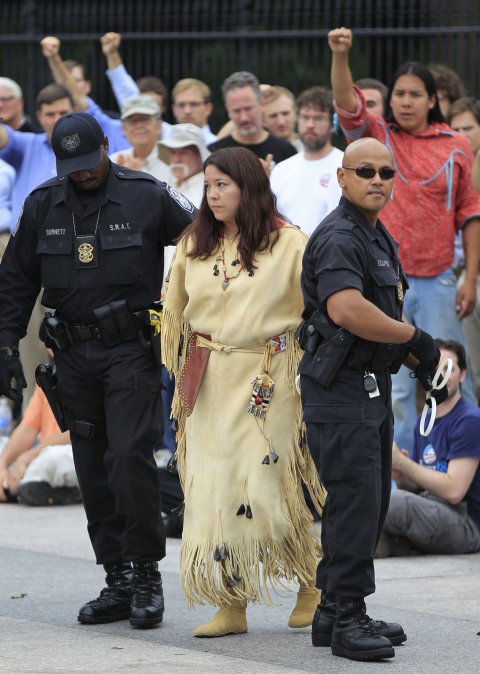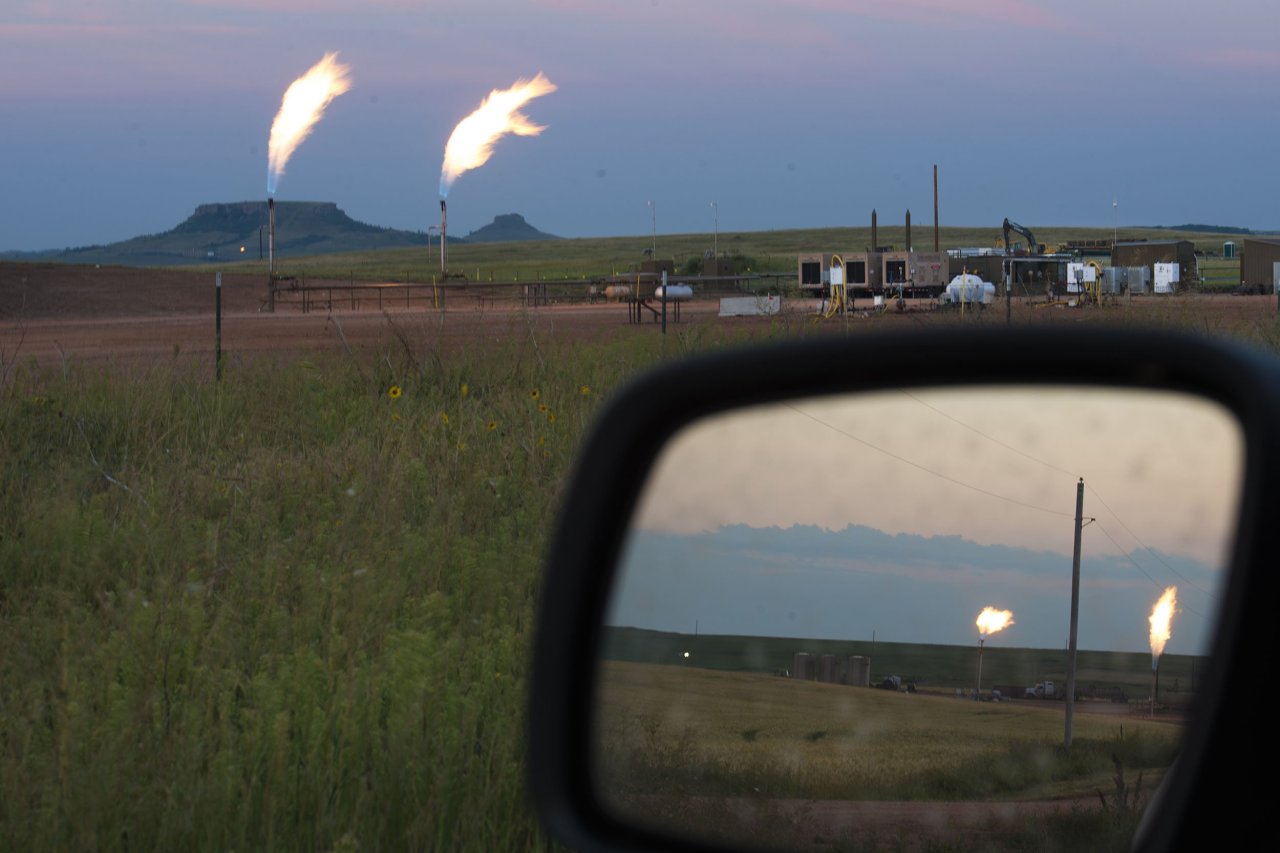Kandi Mossett plans to accompany an extraordinarily influential lobbyist to the United Nations 21st Conference of the Parties (COP21): her 2-year-old daughter, Aiyana. Mossett, a member of the Native American Mandan, Hidatsa and Arikara (MHA) Nation, has spent most of her life on the Fort Berthold Indian Reservation in North Dakota, which, since 2006, has been the center of what would become the second-largest domestic oil boom in U.S. history. It came with little warning or government regulation, but a lot of jobs and money followed. So did a host of climatic, environmental, public health, social, political and even economic costs. "It's been like death by a thousand cuts," says Mossett, the native energy and climate campaign organizer for the Indigenous Environmental Network (IEN), and one of an estimated 20,000 nongovernmental organization delegates to the U.N. conference.
Mossett hopes Aiyana's presence will force President Barack Obama and every other head of state and government negotiator present to see with their own eyes "the people who they are making decisions for…those of us who live on the front lines of fossil fuel extraction. Those of us who will bear the full consequences of their decisions."
Obama is pushing for an ambitious accord at the COP21 in Paris, and to do that he will need the help of activists like Mossett and the tens of thousands of others in Paris she is joining in protests, panels and more to not only convince their governments to sign an accord but also ensure that commitments made in Paris are implemented, enforced and expanded upon at home. Mossett, a veteran of two COPs, shares the certainty of many in Paris that a historic agreement will be reached, one that commits governments to the first-ever legally binding international climate accord. But she is concerned that it will not go nearly far enough.
The heart of the North Dakota oil boom is lit with wild flames, night and day. They appear everywhere and all at once—bright yellow and occasionally black bursts of fire roll low along the earth, blown by wind, or shoot 20 feet or more into the sky. The release of natural gas is accompanied by a sound like a rush of air and on occasion an overwhelming stench of sulfur.
"These were never here before," Mossett says, pointing with her chin to the flares as she drives south out of New Town, leaving her mother's home behind her and heading deeper into the farms and cattle ranches that, along with the omnipresent oil operations, dominate the 980,000-acre reservation. Her uncle lives on and works a 360-acre parcel of land here originally owned by her grandfather. After pulling into his dirt driveway, Mossett shares a video on her phone of a fire that erupted across the road a week ago. Heavy black smoke and flames pour out of the wellhead for over six hours before finally being brought under control .
Mossett grew up in homes all over the reservation. She moved to Montana two years ago when Aiyana's father got a job there, but work and family frequently bring her back. She often considers moving back, but she says, "I worry about Aiyana's health when we're here, what's in the air she's breathing, the water she drinks." Her voice trails off. Her toddler, watching a movie in the backseat of the car, coughs painfully, as if on cue.
The vast majority of North Dakota oil production comes from hydraulic fracturing, or fracking, including from the Bakken Formation underneath the reservation. It's common for oil and natural gas to reside together, but in North Dakota drillers are primarily interested in the more abundant oil. When they're not required to build the infrastructure to capture and sell the natural gas—such as pipes—the cheapest option is to burn it off at the wellhead.
Because of a lack of regulation, nearly 40 times more natural gas was flared or vented (released directly into the air without burning) in North Dakota in 2014 than in 2005, with 102,855 million cubic feet released in 2014, almost half the total for the entire country. The surge brought the U.S. the dubious distinction of joining the list of the world's top five worst flarers, which are, in descending order: Russia, Nigeria, Iran, Iraq and, since 2012, the U.S. The scenic buttes of the reservation's famed North Dakota Badlands, where wild mustangs still roam, are now alight with the flames of flares so numerous and bright that they're visible from space .
Flaring emits carbon dioxide and methane, which is a potent greenhouse gas with a global warming potential more than 25 times greater than that of carbon dioxide. Flaring also produces a slew of other pollutants linked to serious public health effects, including asthma, cancer and early death from respiratory and cardiovascular causes. The pollutants can harm animals, crops and vegetation; land in flaring areas in Nigeria, for example, has lost fertility because of soil acidification.

The darker a flare burns, the more pollutants it releases. Most flares burn yellow, but substandard or poorly maintained equipment, accidents or drilling errors can cause a flare to burn black, releasing black carbon, a major component of soot.
Flaring is one of the most visible problems associated with the fracking boom, but it's far from the only concern. Accidents, fires, blowouts, leaks, spills, ruptures and other problems occur regularly in North Dakota, with nearly 1,800 such incidents reported in the past 12 months, according to the North Dakota Industrial Commission. And that might be a lowball estimate; the Associated Press uncovered 750 "oil field incidents," including pipeline leaks and other oil spills, from January 2012 to October 2013 that were not reported to the public. Meanwhile, the number of oil and wastewater spills per well in North Dakota almost tripled between 2004 and 2013.
Oil spills are bad, but wastewater is what most worries Edmund Baker, the director of the MHA Nation's Environmental Division—"at least oil's organic, and it's easier to clean up." In addition, because oil makes companies money, they're apt to try not to waste it. Wastewater, an unwanted by-product of the oil drilling process, contains fracking chemicals, oil, radioactive material and water that's been dredged up from deep underground—and which, in North Dakota, is 17 times saltier than ocean water. It can destroy farmland, sterilizing the soil for decades.
In July 2014, 1 million gallons of wastewater spilled on the reservation from an underground pipe owned by Crestwood Midstream. The EPA found that the wastewater reached Lake Sakakawea, the primary drinking water source for the MHA Nation and its "cultural and spiritual center," Baker says. Though the MHA is a sovereign nation endowed with the authority to regulate much of the oil operations on its territory, it lacks the capacity and, in most cases, the will to do so. Baker is frustrated. The water, he says, "is a waste product, and I am the janitor," coming in after a spill and mopping up the mess.
The environmental damage done by fracking is pervasive. But, says Mossett, "people don't often believe it until they see it with their own eyes. And a lot of it won't even be felt or seen for 20, 30, 40 years, and that's what keeps me up at night." Which is why Mossett and IEN will join Greenpeace, 350.org, the Sierra Club and at least 130 other domestic and international organizations in delivering a "Keep Fossil Fuels in the Ground" declaration at a press event on December 6 in Paris. Co-author Esperanza Martinez of Ecuador's Acción Ecológica, delivered the original proposal to achieve this goal eight years ago at COP13 in Bali. In 2014, the U.N. Intergovernmental Panel on Climate Change reached the same conclusion, and top U.N. climate official Christiana Figueres warned that in order to meet the internationally recognized threshold for avoiding the most dangerous effects of climate change—limiting the world to 2 degrees Celsius (3.6 degrees Fahrenheit) of warming over pre-industrial levels—"three-quarters of the fossil fuel reserves need to stay in the ground."
The declaration makes several demands of governments: the end of subsidies to the fossil fuel industry, that the wealthier countries of the world promise to fund a "just transition to a clean and renewable energy economy for all" and, most importantly, that fossil fuels be kept in the ground by ending exploration and new extraction. The goal, explains Andrew Miller of the San Francisco–based Amazon Watch, is to change the discourse at the COP—most of the climate-related commitments countries have made to date have focused largely on the consumption side of the fossil fuel problem, continuing to ignore the critical production and supply sides.
"Keep it in the ground!" is the rallying cry unifying many Paris events. They were also the words used on November 6 by President Obama in his public statement explaining his decision to reject the Keystone XL oil pipeline. "Ultimately, if we're going to prevent large parts of this Earth from becoming not only inhospitable but uninhabitable in our lifetimes, we're going to have to keep some fossil fuels in the ground." However, with a few exceptions (such as a ban imposed on oil and gas drilling in Alaska's Bristol Bay), this hasn't been reflected in his administration's policy to date. Under his guidance, the U.S. has followed an "all-of-the-above" energy strategy—in June, the U.S. emerged as the world's largest producer of oil and natural gas (combined), while U.S. exports of both products are at all-time highs.
One of Obama's major initiatives to lower the U.S.'s impact on global warming is the Clean Power Plan , a set of new regulations to limit emissions from power plants. Though the plan will result in the U.S. consuming less coal, there is nothing in it to stop the same amount of coal from being produced in the States and then shipped to, say, China. Only specific restrictions on production would ensure that fossil fuels are not burned at all.
The failure to date of so many nations, including the U.S., to implement or even propose policies that keep fossil fuels in the ground is one reason the 138 individual climate commitments submitted by nations thus far do not meet the 2 degrees Celsius target. According to an analysis by Climate Action Tracker , the commitments currently project to limit us to approximately 2.7 degrees Celsius of warming—not nearly enough.
Government restriction on fossil fuel production isn't that crazy of an idea. In fact, it's already being done in fits and starts. In 1982, for example, the federal government imposed moratoriums banning any new offshore oil drilling off the U.S. Pacific and Atlantic Coasts—though, under heavy industry lobbying, they were lifted in 2008. And in the last several years, because of intense public pressure, local bans and moratoria on oil and natural gas drilling, particularly using fracking, have proliferated across the U.S., including a fracking ban on the entire state of New York. The reason you don't see drilling rigs in Yellowstone National Park or the Grand Canyon isn't the lack of interest among energy companies—it's because such activities are banned there, as in most National Parks. And right now, up for debate in Congress is the "Keep It in the Ground Act of 2015" introduced on November 4 by Senators Bernie Sanders (I-Vt.), Jeff Merkley (D-Ore.), Ben Cardin (D-Md.), Barbara Boxer (D-Calif.), Kirsten Gillibrand (D-N.Y.), Patrick Leahy (D-Vt.), and Elizabeth Warren (D-Mass.), that, if passed, would end new federal fossil fuel leasing on all public lands and oceans, and cancel all existing offshore federal oil and gas leases in the Arctic, removing up to 450 billion tons of potential greenhouse gas pollution from publicly owned coal, oil and gas.
The easiest time to stop a fossil fuel project is before it has begun. Mossett has worked hard on that front; she was a leader in the seven-year-long effort to stop the Keystone XL pipeline. But in many cases—including Mossett's family home on the Fort Berthold Indian Reservation—it's too late. She now has to focus on the more difficult challenge of halting operations already underway and picking up the broken pieces left behind as the shine of the oil boom wears off.
"There's a fallout you've got to deal with," says Baker, who describes living in the North Dakota oil fields like being at the end of a party, where people are looking around at the broken glass bottles, empty cups and people passed out on the floor. That's when you start to question if it's really been worth it. Increasingly on Fort Berthold, the answer is no.
Antonia Juhasz (@AntoniaJuhasz) is the author of several books, including most recently Black Tide: The Devastating Impact of the Gulf Oil Spill.






















